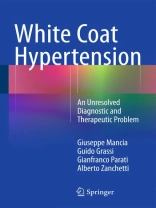This book addresses all aspects of white coat hypertension – the phenomenon of raised blood pressure in a medical setting yet not elsewhere – from its history to its pathophysiology, diagnosis and treatment. White coat hypertension is a common condition, accounting for 30–40% of the overall hypertensive population. While many studies have addressed this condition, controversy still exists over whether it causes an increased risk to sufferers and should be treated.
In the volume neurogenic and non-neurogenic mechanisms are discussed and the significance of various predictive factors, evaluated. The association of white coat hypertension with dysmetabolic risk factors, new-onset diabetes and other conditions is carefully reviewed. Further chapters consider the occurrence of asymptomatic organ damage and cardiovascular outcomes in affected patients and helpful guidance is also provided on the controversial issue of when to treat and when not to treat. White Coat Hypertension is based largely on work done during the past 30 years by renowned researchers working in Milan, who have made key contributions in improving knowledge of the condition and whose work is well known across the world.
Содержание
1 Historical Notes.- 2 Definition, Terminology and Prevalence.- 3 Diagnostic Approach to white coat effect and white coat hypertension.- 4 Neurogenic and Non-neurogenic Mechanisms.- 5 Predictive Factors.- 6 White coat hypertension and cardiovascular morbidity and mortality.- 7 White coat hypertension and Target Organ Damage.- 8 White Coat Hypertension, metabolic risk factors, and cardiovascular risk profile.- 9 To Treat or Not To Treat?.












